-25.jpg)
New Contemporaries, Institute of Contemporary Arts, London, 2025. Photo: Rob Harris.
ICA, London
14 January – 23 March 2025
by TOM DENMAN
Selected by the artists Liz Johnson Artur, Permindar Kaur and Amalia Pica, almost all 35 participants at the 75th iteration of New Contemporaries – an annual exhibition showcasing artists who have recently graduated from a UK university – are engaging, in one way or another, with the practice of everyday life, with being in the world as something that we do. When the artists are concerned with what are generally seen as the chief political issues of contemporary art, they approach it first and foremost in terms of what the sociologists call habitus – the way we internalise our environment and thereby reproduce it. What does our alienation in the city look and feel like? How do we live with the edifices of a defunct industry? How does it feel to sit in a pseudo-Victorian dining chair? In the broadest sense, in what feels like a response to the powerlessness of any group that might be classed as emerging today, how to survive and how to live in the contemporary world – as opposed to how to get people in power to change it, the butterfly effect or whatever – may as well be the show’s guiding questions.
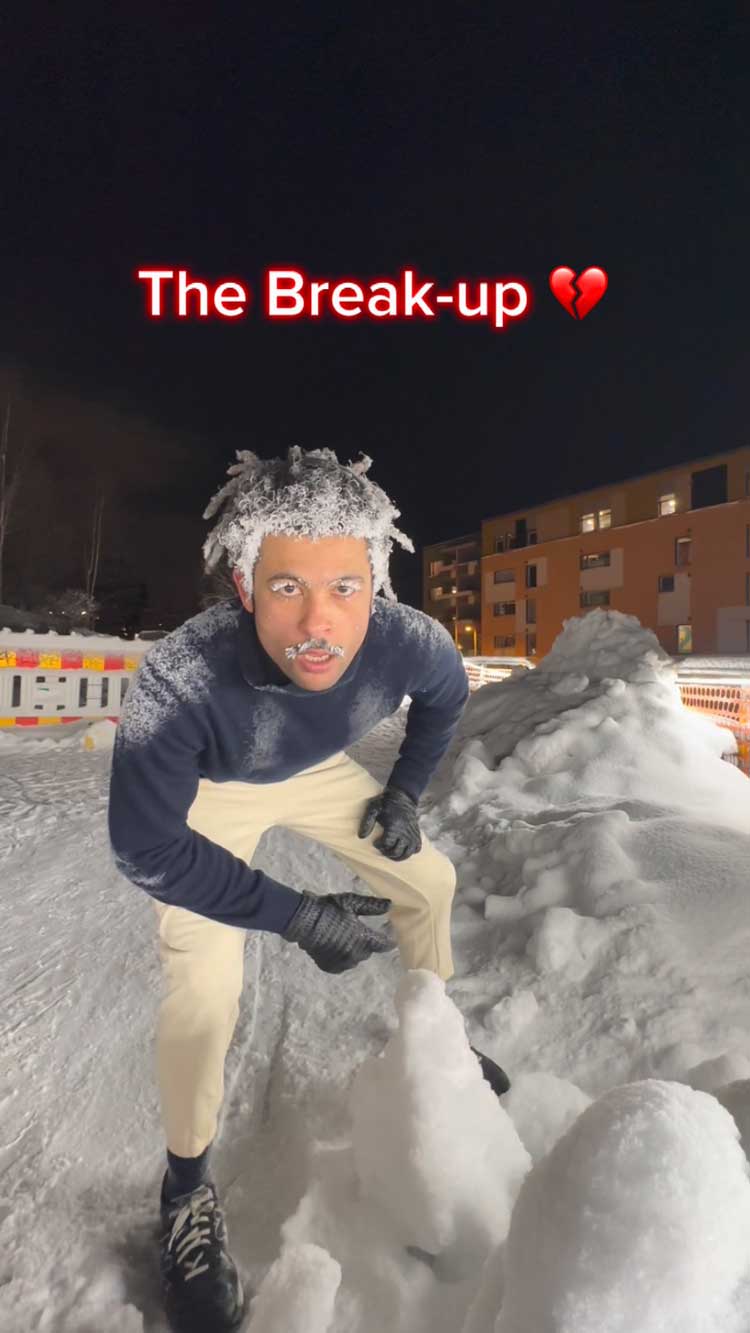
Elliott Roy, A Content replaces Another, 2024. Instagram and Tik Tok videos. Courtesy of the Artist.
One of the first works we encounter is explicit about this impetus. Elliott Roy’s A Content Replaces Another (2024) is a sequence of clips in which the artist films himself running, jumping and somersaulting through various cities, bringing corporal urgency to the bitesize tutorials he delivers on Lime bikes, monuments and the necessity of structured limitation in a world frenzied with choice. The artist Molly Burrows has made a booklet containing an illustrated guide to some of the artists, writing and designing it in an unthreatening, ease-of-access way to make people – especially newcomers to contemporary art – feel at home. Both works provide a map of sorts that demystifies the world around us.
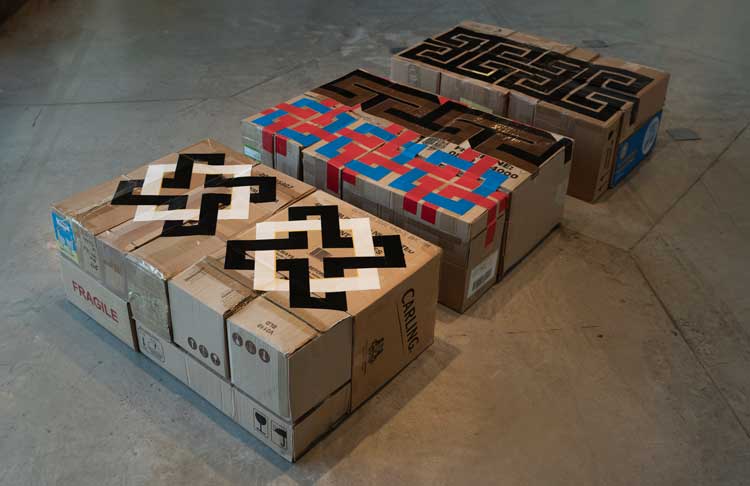
Anna Howard, Veneer, 2024. Cardboard and tape. Photo: Dom Moore.
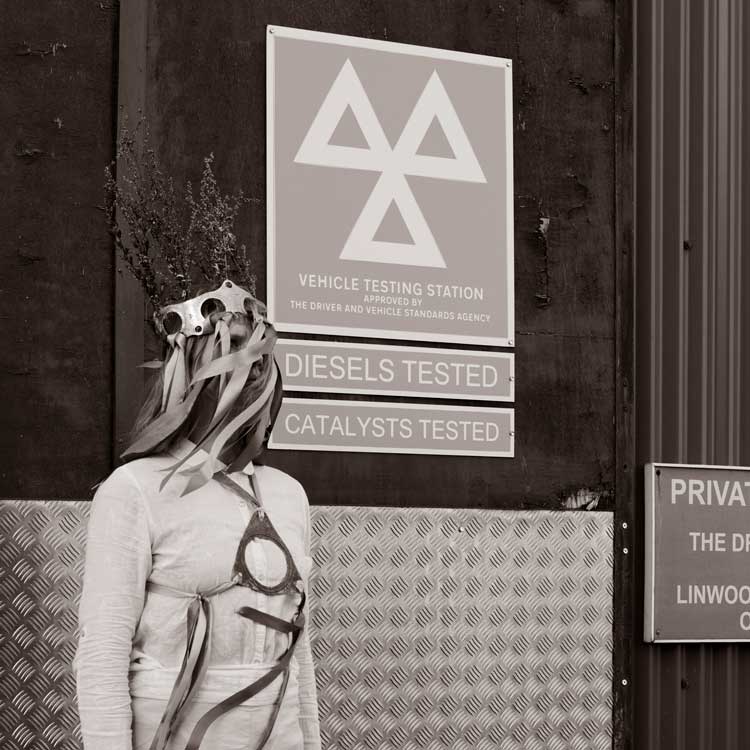
Libby Bove, So turns the wheel of the M.O.T. - A Journey through the imagined history of folk customs associated with the annual vehicle safety test, 2023. Photographic installation with sound. Courtesy of the Artist.
In a more opaque manner, how we might give meaning to vernacular infrastructure – and thereby recode ornament as social intervention – seems to be fundamental to Anna Howard’s Veneer (2025), a pair of cuboids made of carboard boxes Tetris-ed together, set slightly apart, with ornamental, geometric patterns made with sticky tape along the top. The playfully enigmatic work is well placed next to Libby Bove’s photographs of people dressed in makeshift, folky, ritualistic costumes, stomping and singing outside service stations, accompanied by the sound of truck engines. Bonfire rituals are at the heart of Fergus Carmichael’s exquisite Rhadinace (2024), a film documenting – in the most creative sense – life in a Scottish coastal community with the looming, God-like presence of defunct offshore oil rigs. As what might be called a tactic of survival, these artists strive to attend to the potential meaning, creativity and even the magic of the industrial and post-industrial everyday.
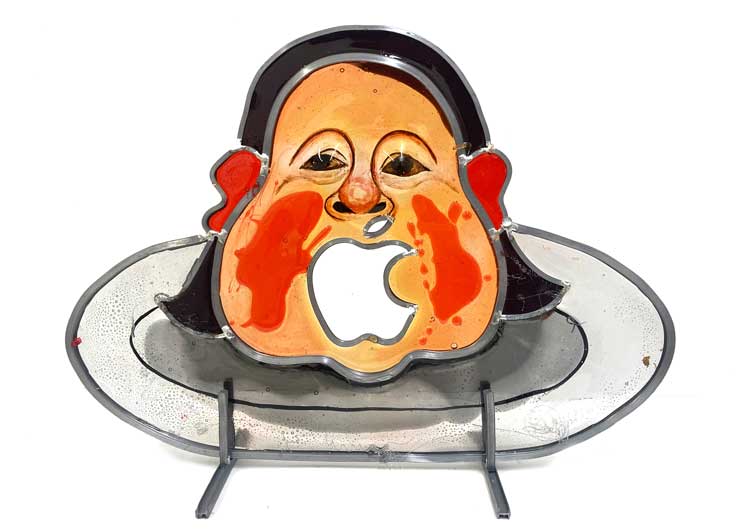
Sophie Lloyd, I love apple and
apple loves me, 2023. Sugar and lead. Courtesy of the Artist.
In a show predominantly about being in the world, it may be natural that home – including what it means to feel “at home” – is the predominant theme. Bear in mind that many of the artists here would have gone through the unprecedentedly widespread process of attending university remotely, not to mention the cost-of-living crisis preventing people starting out in the arts from living independently. These conditions have made the home a site of political action more than it has been in recent decades, especially for those who feel unheard – if they are not silenced outright – in the public sphere. The politics of domesticity are palpable in the number of works that incorporate interior design or household objects, such as Sophie Lloyd’s stained-glass caricature with an Apple-logo-shaped orifice for a mouth, served on a platter, or Roo Dhissou’s dining table with plates, tablecloth and napkins bearing phrases that talk about the complexities of cross-cultural interaction. Even the paintings of Hazel O’Sullivan, with their retrofuturist, tubular configurations and painted-in, carpetlike borders, reclaim the aesthetics of 1970s postmodern design.
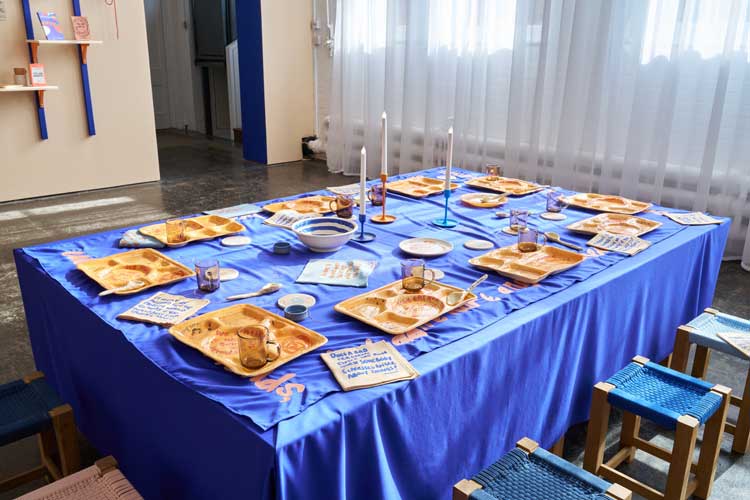
Roo Dhissou, Eat, drink, chill, but don't hurt anyone's heart, 2023. Installation of ceramics, textiles and glass. Courtesy of the Artist.
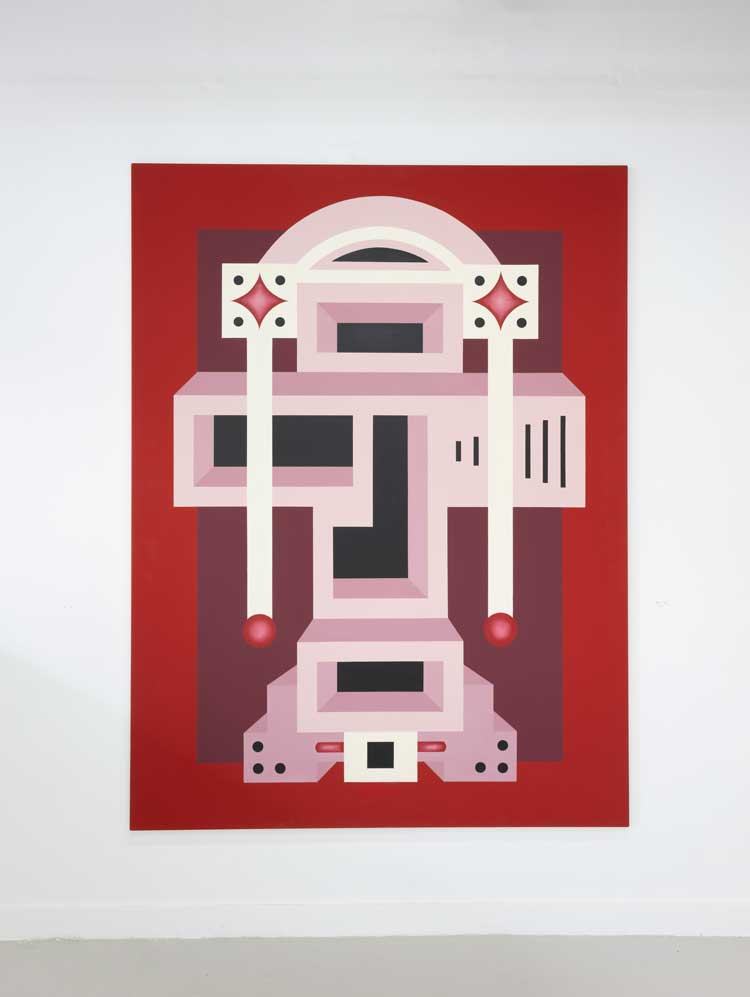
Hazel O’Sullivan, Sidhe, 2024. Acrylic on stretched canvas. Photo: Isabella Scott.
.jpg)
Farzaneh Ghadyanloo, Thursdays, 2024. Photograph.
Family, practically synonymous with home, frequently comes up. Farzaneh Ghadyanloo’s photographs of her family in Tehran are taken from a viewpoint so immersed in the scene that they are at once intimate and enigmatic, or enigmatic in their intimacy (the more involved with a family you are, the more enigmatic it can become).
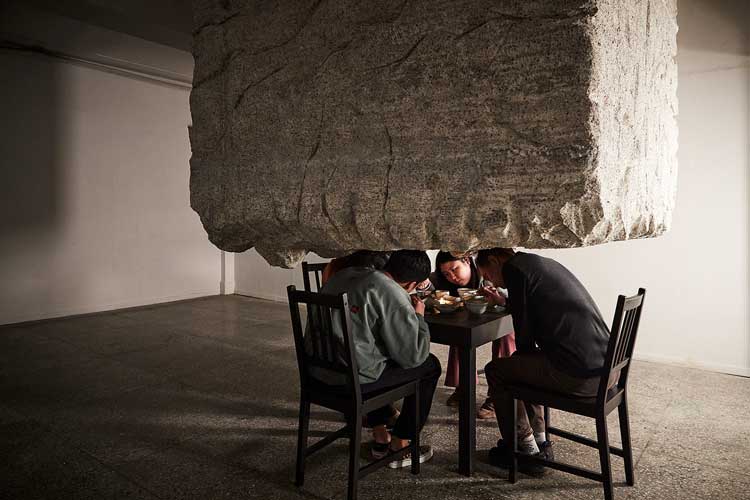
Sun Oh, Dinner with Family, 2021. Moving image. Courtesy of the Artist.
Sun Oh takes a more surrealist approach in her film, Dinner With Family (2024), in which the family of four are forced to stoop over their bowls by the presence of a giant, low-hanging stone: another enigma, perhaps, or an unspoken, never-resolved issue. Family tensions are just as ironically felt in AC Larsen’s Supper Time (2024), in which a “vintage early 1990s G Plan dining chair” is upholstered with “Adidas Originals tracksuit”. The covetous detail of the wall label’s description recalls the captioning in fashion magazines, wittily gesturing to the fraught and fleeting performativity of appropriateness, affinity and belonging.
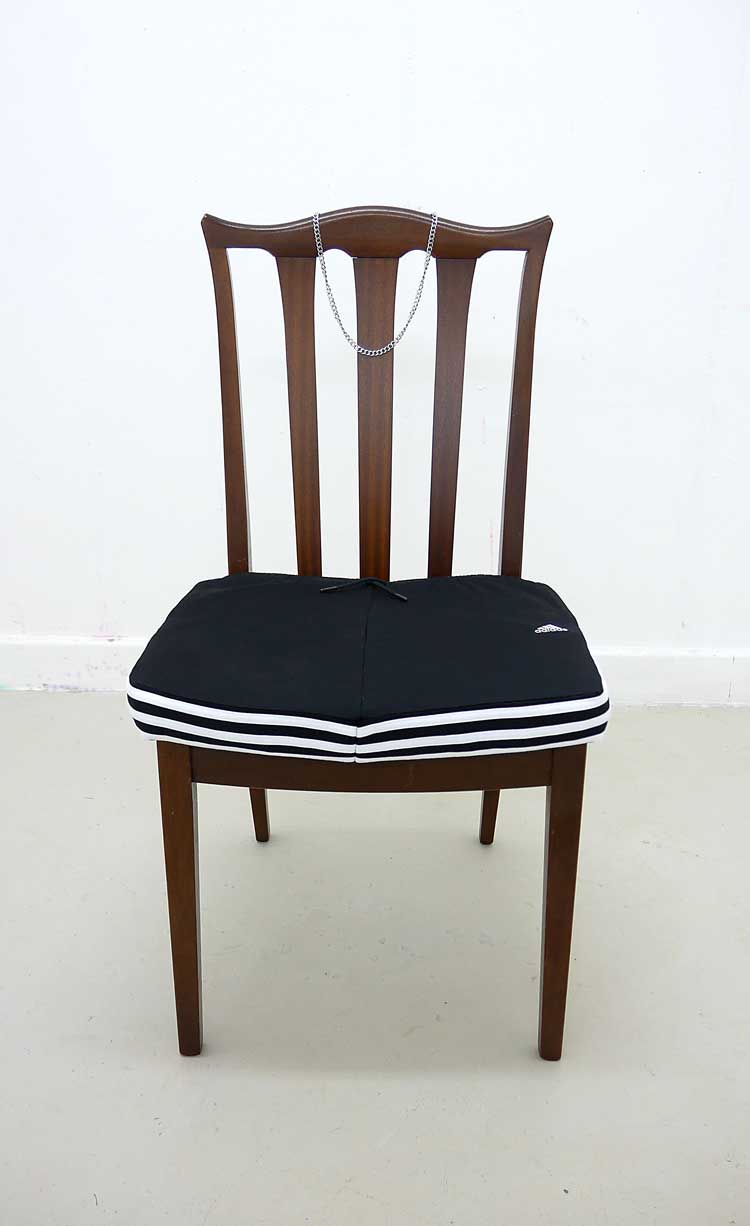
AC Larsen, Supper Time, 2024. Vintage early 1990s G Plan dining chair, Adidas Originals tracksuit, stainless steel Cuban chain. Courtesy of the Artist.
ceiling.jpg)
Motunrayo Akinola, Grandma’s (gl)ceiling, 2023. Installation. Courtesy of the Artist.
Fundamental to feeling at home are access and acceptance. Motunrayo Akinola’s Grandma’s (gl)ceiling (2023), which acts as a reproduction of an actual peeling ceiling, suspended high in one of the gallery’s upstairs corridors – a discretely deployed, familiar presence in what has historically been a zone of social exclusivity. In a performance (one of four live works staged during the exhibition), Akinola elaborated on the imbalances of institutional hospitality by dividing us between those he enthusiastically applauded and those he damned with faint praise. Belonging was central also to Sara Graça’s live presentation, which consisted of a slideshow following a young man as he roamed aimlessly about town. The overexposed, ethereal photographs caused me to think about our fading physical identification with the built environment, and more so when – the screen becoming a shadow theatre – the man is greeted by puppet aliens, with the ensuing narrative revolving around an interdimensional struggle for recognition.
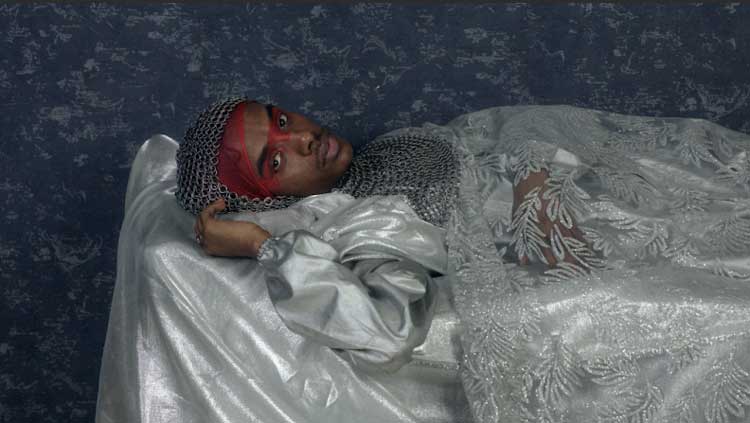
Asmaa Jama and Gouled Ahmed, Except this time nothing returns from the ashes, 2023. Moving image. Courtesy of the Artist.
In varying ways, the desire to feel at home, whether that home is a fixed place or self-possession in a state of transit, underpins the subjectivity of migrancy. In Asmaa Jama and Gouled Ahmed’s film Except This Time Nothing Returns from the Ashes (2023), a spectral couple travel through a city while a voiceover cantillates the diasporic condition: “We wander too far in the city, we are unseen beings, we swarm and electrify, bright afterimages.” Sara Osman’s Battle for Home (2023) painfully explores another struggle of dispossession: a community’s commitment to a home on the brink of ruin. The circle of tiny, crumbling, almost anthropomorphic buildings responds to the decimated houses in war-torn parts of the Middle East. Its scale and position on the floor, and our fighter jet-view, implicate us in our detachment and complicity, asking us to kneel down: to at least try to fathom the plight of the dispossessed, if only to reckon with the impossibility of fully doing so.
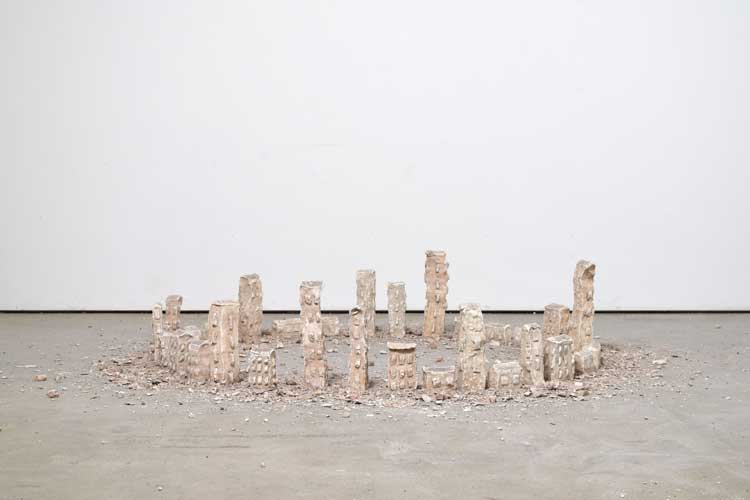
Sara Osman, Battle for Home, 2023. Plaster, soil and clay. Courtesy of the Artist.
As difficult as it is to give mention to all the artists in this promising show, it would be unfair to ignore those who don’t fit into the rubric I have identified. And yet the more I think about them, the less they seem to be outside it. Belonging can also be found beyond the community’s edge: Valentino Vannini’s spindly, viscous, broken columnar sculptures are like trees, but trees which obey a distorted, wastelandic course of evolution – a reference, the artist explains, to an out-of-bounds realm where people are free of social constraints. Max Boyla’s Fire of Love (2023) is seemingly further removed from material and social life, and yet the painting’s pair of shimmering, rippling helixes invite meditation on the cosmos, and our place within it. Comparably, Joshua Whitaker’s film The Form an Object Takes in Oblivion (2024) – with the subtitle “To Live in Hell and Not Despair” – follows a puppet of Pier Paolo Pasolini as he writes his (never filmed) screenplay about Saint Paul’s ecstatic conversion. Both works are about the practice of being in the world – on a metaphysical level.
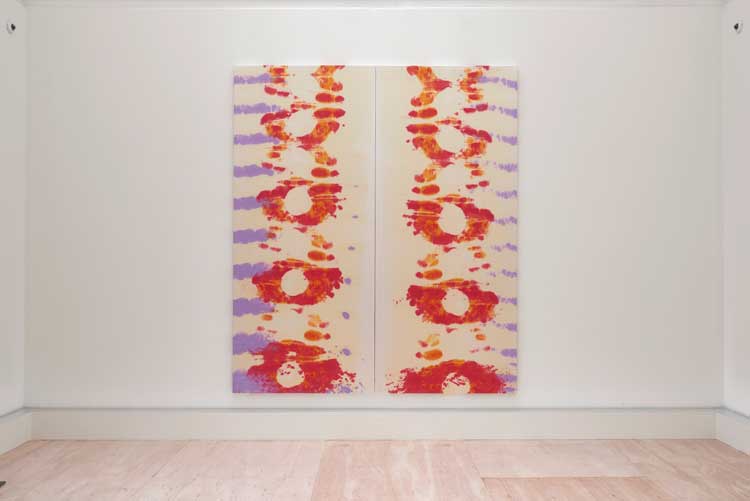
Max Boyla, Fire of love, 2023. Oil on satin. Courtesy of the Artist.
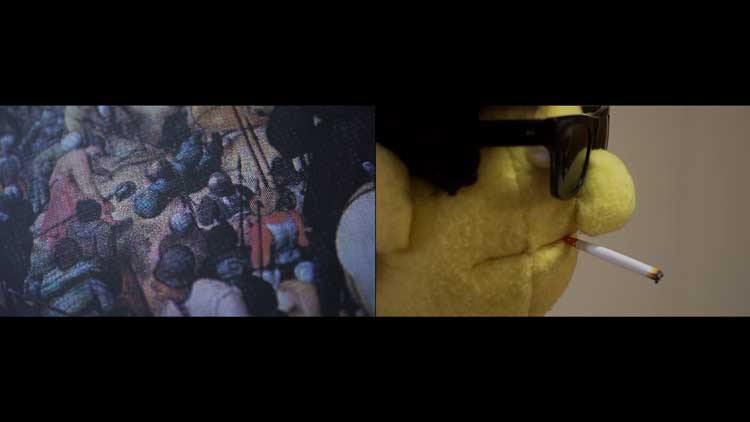
Joshua Whitaker, The Form an Object Takes in Oblivion, 2024. Moving image. Courtesy of the Artist.
New Contemporaries is not necessarily a guide to the art of the future – as recent graduates, these artists may have yet to significantly distance themselves from the lessons of their more established teachers. Nevertheless, it certainly offers a glimpse of some of the core concerns of the present moment, and a chance to speculate about what they are and where they stem from. Given the increasing economic, political and moral precarity of contemporaneity, and the powerlessness many might feel as to getting anyone with power to do anything about it, and the sheer sense of distance between those with power and those without it – especially when that distance is generational – all we really have is each other, and in our solidarity is resistance.